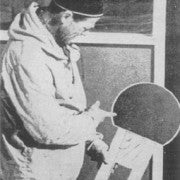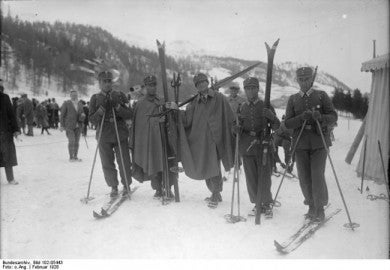The summer Olympic Games include more than a few shooting competitions – rifle, pistol, and shotgun in several disciplines. But frankly, they are pretty dull to watch. No disrespect to the athletes (who are amazing shooters), but it’s a solitary challenge, and not something really suited to crowds of cheering spectators. The Winter Games are different, though. They include only one shooting sport, but it’s a heck of a sport: biathlon.
As I am writing this, Norwegian Ole Einar Bjørndalen is on the cusp of becoming the single most successful Winter Olympics athlete in history. He has competed in every games since 1994, and won medals in every one since 1998, including a total of 7 golds. He is no less than 40 years old now, and has already taken a Biathlon Gold in Sochi, in the face of competitors virtually half his age.
For those who aren’t familiar with it, Biathlon is a sport combining cross-country skiing with rifle shooting. It is (not surprisingly) Nordic in origin, and combines the all-around fitness required to be a competitive cross-country skier with the discipline and mental focus required to be a competitive rifle shooter. A typical Biathlon competition involves skiing a set distance circuit, ending at a rifle range where a number of targets must be engaged. Any missed targets result in a time penalty or an additional penalty distance that must be skied. The circuit and the shooting is repeated several times, and the winner is the competitor with the fastest adjusted time.
In today’s Olympics, the distances vary from 10k to 20k (6.2 – 12.4 miles) depending on the event, and the shooting is done at 50m with a .22LR bolt action rifle (the typical competitive action uses a toggle type of bolt, which can be flicked open and shut with the trigger finger without disturbing the shooter’s hold or cheek weld). The competitor shoots at the bank of 5 targets 4 times, for a total of 20 shots (and only one attempt is allowed on each target). Half are shot prone (at a 45mm/1.8″ target) and half are shot offhand (at a 115mm/4.5″ target). By any reckoning, it is a challenging event. Any yet, it is not the challenge that it used to be…
-
Back in the 1960 Olympics at Squaw Valley California, the biathlon was still being held with full power rifles instead of .22 target rifles (the transition to .22s would happen in 1978). The shooting consisted of 200m prone at the 6.5k mark, 250m prone at the 9.5k mark, 150m prone at the 12.5k mark, and 100m offhand at the 15k mark (and then another 5k ski to the finish). As with today, only one shot was allowed at each target. The sport was evolving, and the competitors were using purpose-built target rifles, often in 6 or 6.5mm. They were still conventional bolt actions with aperture iron sight, though – the American team used Winchester Model 70s in .243 Winchester. Another popular biathlon cartridge at the time was the 6.5x54R – the standard Soviet military cartridge necked down to 6.5mm for reduced recoil and a flatter trajectory.
Swede Klas Lestander took first place in the 1960 Games, with a time of 1 hour, 33 minutes, 21.6 seconds – and a perfect shooting score. Second place went to Finn Antti Tyrvainen, who had a faster raw time (1:29:57.7), but missed a shot at 200m and one at 250m, resulting in a 4-minute penalty and dropping him to second place. Third was Russian Aleksandr Privalov, who had an even faster raw time of 1:28:54.2, but missed three of the offhand shots, for a 6-minute penalty.
The biathlon 50 years ago had more of the original military character of the sport than today’s version, but by the 1960s it was already transitioning away from its military roots towards a more genteel civilian sport. The Biathlon’s first Olympic appearance was in the 1924 Chamonix Games in Paris. There, it was held under the name “Military Patrol” and was a blatantly martial event.
Military Patrol followed the same basic outline as today’s biathlon, although it was more grueling and was a team event. A four-man team was composed of a leader (typically an officer) and three subordinates (typically two privates and an NCO). The three men carried service rifles and did the shooting, while the officer led the team, carried a pistol, and did not do any shooting (he could carry another team member’s rifle on the course, but not at any of the shooting stations or at the start or finish lines). The course was 30 kilometers long (18.6 miles), and include 500-1200m of elevation gain (I can’t find the exact number for 1924, but the 1928 course included 1100m of elevation gain). Oh, and the three men had to carry weighted backpacks (either 24kg each or 24kg combined; sources conflict on this point). Partway through the ski course there was a single shooting station, with 18 targets at 250m. Each of the three riflemen would have six shots to make as many hits as possible, and each hit would confer a 30 second bonus to the team’s time.
In the 1924 Olympics, the gold medal was taken by the Swiss team, with a raw time of 4 hours and 6 seconds, and 8 targets hit for a 4 minute bonus. The Finnish team took 4 hours, 5 minutes and 40 seconds to complete the course but had the best marksmanship, with 11 targets hit. The bonus times from those hits put them a mere 4 minutes behind for the silver medal. Third went to France (with a disappointing 2 targets hit) and fourth to Czechoslovakia. The other two teams competing, from Italy and Poland, both failed to complete the course (a sure sign of a thoroughly challenging competition).
Military Patrol would prove to be a one-time deal as an official Olympic event, although it was also included in the 1928, 1936, and 1948 Games as a demonstration sport. Modern biathlon was brought into the Games in 1960, and has been there ever since, with a transition from centerfire to rimfire rifles in 1978. It is a sport requiring power and endurance as well as pinpoint precision and discipline, and it is a sport in which the athlete himself or herself will always be far more important the outcome than their equipment.
So if you are watching the primetime coverage of the Olympics and trying to figure out the how they score the figure skating or what the practical application of ski jumping for distance is, you should consider heading to your computer to find the coverage of the best winter Olympic sport: Biathlon.
And good luck to Ole!
 Your Privacy Choices
Your Privacy Choices


